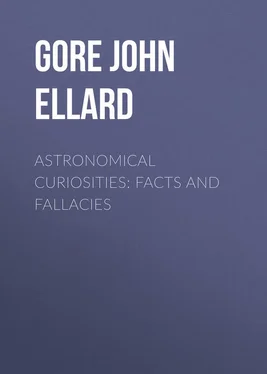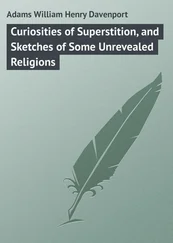John Gore - Astronomical Curiosities - Facts and Fallacies
Здесь есть возможность читать онлайн «John Gore - Astronomical Curiosities - Facts and Fallacies» — ознакомительный отрывок электронной книги совершенно бесплатно, а после прочтения отрывка купить полную версию. В некоторых случаях можно слушать аудио, скачать через торрент в формате fb2 и присутствует краткое содержание. Жанр: Физика, foreign_antique, foreign_prose, на английском языке. Описание произведения, (предисловие) а так же отзывы посетителей доступны на портале библиотеки ЛибКат.
- Название:Astronomical Curiosities: Facts and Fallacies
- Автор:
- Жанр:
- Год:неизвестен
- ISBN:нет данных
- Рейтинг книги:5 / 5. Голосов: 1
-
Избранное:Добавить в избранное
- Отзывы:
-
Ваша оценка:
- 100
- 1
- 2
- 3
- 4
- 5
Astronomical Curiosities: Facts and Fallacies: краткое содержание, описание и аннотация
Предлагаем к чтению аннотацию, описание, краткое содержание или предисловие (зависит от того, что написал сам автор книги «Astronomical Curiosities: Facts and Fallacies»). Если вы не нашли необходимую информацию о книге — напишите в комментариях, мы постараемся отыскать её.
Astronomical Curiosities: Facts and Fallacies — читать онлайн ознакомительный отрывок
Ниже представлен текст книги, разбитый по страницам. Система сохранения места последней прочитанной страницы, позволяет с удобством читать онлайн бесплатно книгу «Astronomical Curiosities: Facts and Fallacies», без необходимости каждый раз заново искать на чём Вы остановились. Поставьте закладку, и сможете в любой момент перейти на страницу, на которой закончили чтение.
Интервал:
Закладка:
The diameter of Mercury is usually stated at about 3000 miles; but a long series of measures made by Prof. See in the year 1901 make the real diameter about 2702 miles. This would make the planet smaller than some of the satellites of the large planets, probably smaller than satellites III. and IV. of Jupiter, less than Saturn’s satellite Titan, and possibly inferior in size to the satellite of Neptune. Prof. Pickering thinks that the density of Mercury is about 3 (water = 1). Dr. See’s observations show “no noticeable falling off in the brightness of Mercury near the limb.” There is therefore no evidence of any kind of atmospheric absorption in Mercury, and the observer “gets the impression that the physical condition of the planet is very similar to that of our moon.” 17 17 Ast. Nach. No. 3737.
Schröter (1780-1815) observed markings on Mercury, from which he inferred that the planet’s surface was mountainous, and one of these mountains he estimated at about 11 miles in height! 18 18 Observatory , September, 1906.
But this seems very doubtful.
To account for the observed irregularities in the motion of Mercury in its orbit, Prof. Newcomb thinks it possible that there may exist a ring or zone of “asteroids” a little “outside the orbit of Mercury” and having a combined mass of “one-fiftieth to one-three-hundredth of the mass of Venus, according to its distance from Mercury.” Prof. Newcomb, however, considers that the existence of such a ring is extremely improbable, and regards it “more as a curiosity than a reality.” 19 19 Nature , November 29 and December 20, 1894.
M. Léo Brenner thinks that he has seen the dark side of Mercury, in the same way that the dark side of Venus has been seen by many observers. In the case of Mercury the dark side appeared darker than the background of the sky. Perhaps this may be due to its being projected on the zodiacal light, or outer envelope of the sun. 20 20 Bulletin, Ast. Soc. de France , July, 1898.
Mercury is said to have been occulted by Venus in the year 1737. 21 21 Observatory , vol. 8 (1885), pp. 306-7.
But whether this was an actual occultation, or merely a near approach does not seem to be certain.
The first transit of Mercury across the sun’s disc was observed by Gassendi on November 6, 1631, and Halley observed one on November 7, 1677, when in the island of St. Helena.
Seen from Mercury, Venus would appear brighter than even we see it, and as it would be at its brightest when in opposition to the sun, and seen on a dark sky with a full face, it must present a magnificent appearance in the midnight sky of Mercury. The earth will also form a brilliant object, and the moon would be distinctly visible. The other planets would appear very much as they do to us, but with somewhat less brilliancy owing to their greater distance.
As the existence of an intra-Mercurial planet (that is a planet revolving round the sun within the orbit of Mercury) seems now to be very improbable, Prof. Perrine suggests that possibly “the finely divided matter which produces the zodiacal light when considered in the aggregate may be sufficient to cause the perturbations in the orbit of Mercury.” 22 22 Nature , October 30, 1902.
Prof. Newcomb, however, questions the exact accuracy of Newton’s law, and seems to adopt Hall’s hypothesis that gravity does not act exactly as the inverse square of the distance, and that the exponent of the distance is not 2, but 2·0000001574. 23 23 Charles Lane Poor, The Solar System , p. 170.
Voltaire said, “If Newton had been in Portugal, and any Dominican had discovered a heresy in his inverse ratio of the squares of the distances, he would without hesitation have been clothed in a san benito , and burnt as a sacrifice to God at an auto da fé .” 24 24 Smyth, Celestial Cycle , p. 60.
An occultation of Mercury by Venus was observed with a telescope on May 17, 1737. 25 25 Denning, Telescopic Work for Starlight Evenings , p. 225.
May transits of Mercury across the sun’s disc will occur in the years 1924, 1957, and 1970; and November transits in the years 1914, 1927, and 1940. 26 26 The Observatory , 1894, p. 395.
From measurements of the disc of Mercury during the last transit, M. R. Jonckheere concludes that the polar diameter of the planet is greater than the equatorial ! His result, which is very curious, if true, seems to be supported by the observations of other observers. 27 27 Ast. Nach. 4333, quoted in Nature , July 1, 1909, p. 20.
The rotation period of Mercury, or the length of its day, seems to be still in doubt. From a series of observations made in the years 1896 to 1909, Mr. John McHarg finds a period of 1·0121162 day, or 1d 0h 17m 26s·8. He thinks that “the planet possesses a considerable atmosphere not so clear as that of Mars”; that “its axis is very considerably tilted”; and that it “has fairly large sheets of water.” 28 28 English Mechanic , July 23, 1909.
CHAPTER III
Venus
Venus was naturally – owing to its brightness – the first of the planets known to the ancients. It is mentioned by Hesiod, Homer, Virgil, Martial, and Pliny; and Isaiah’s remark about “Lucifer, son of the morning” (Isaiah xiv. 12) probably refers to Venus as a “morning star.” An observation of Venus is found on the Nineveh tablets of date B.C. 684. It was observed in daylight by Halley in July, 1716.
In very ancient times Venus, when a morning star, was called Phosphorus or Lucifer, and when an evening star Hesperus; but, according to Sir G. C. Lewis, the identity of the two objects was known so far back as 540 B.C.
When Venus is at its greatest brilliancy, and appears as a morning star about Christmas time (which occurred in 1887, and again in 1889), it has been mistaken by the public for a return of the “Star of Bethlehem.” 29 29 Nature , December 22, 1892.
But whatever “the star of the Magi” was it certainly was not Venus. It, seems, indeed absurd to suppose that “the wise men” of the East should have mistaken a familiar object like Venus for a strange apparition. There seems to be nothing whatever in the Bible to lead us to expect that the star of Bethlehem will reappear.
Mr. J. H. Stockwell has suggested that the “Star of Bethlehem” may perhaps be explained by a conjunction of the planets Venus and Jupiter which occurred on May 8, B.C. 6, which was two years before the death of Herod. From this it would follow that the Crucifixion took place on April 3, A.D. 33. But it seems very doubtful that the phenomenon recorded in the Bible refers to any conjunction of planets.
Chacornac found the intrinsic brightness of Venus to be ten times greater than the most luminous parts of the moon. 30 30 Celestial Objects , vol. i. p. 52, footnote.
But this estimate is probably too high.
When at its brightest, the planet is visible in broad daylight to good eyesight, if its exact position in the sky is known. In the clear air of Cambridge (U.S.A.) it is said to be possible to see it in this way in all parts of its orbit, except when the planet is within 10° of the sun. 31 31 Ibid. , p. 54.
Mr. A. Cameron, of Yarmouth, Nova Scotia, has, however, seen Venus with the naked eye three days before conjunction when the planet was only 6¼° from the sun. 32 32 Astronomy and Astrophysics , 1892, p. 618.
This seems a remarkable observation, and shows that the observer’s eyesight must have been very keen. In a private letter dated October 22, 1888, the late Rev. S. J. Johnson informed the present writer that he saw Venus with the naked eye only four days before conjunction with the sun in February, 1878, and February, 1886.
Интервал:
Закладка:
Похожие книги на «Astronomical Curiosities: Facts and Fallacies»
Представляем Вашему вниманию похожие книги на «Astronomical Curiosities: Facts and Fallacies» списком для выбора. Мы отобрали схожую по названию и смыслу литературу в надежде предоставить читателям больше вариантов отыскать новые, интересные, ещё непрочитанные произведения.
Обсуждение, отзывы о книге «Astronomical Curiosities: Facts and Fallacies» и просто собственные мнения читателей. Оставьте ваши комментарии, напишите, что Вы думаете о произведении, его смысле или главных героях. Укажите что конкретно понравилось, а что нет, и почему Вы так считаете.











